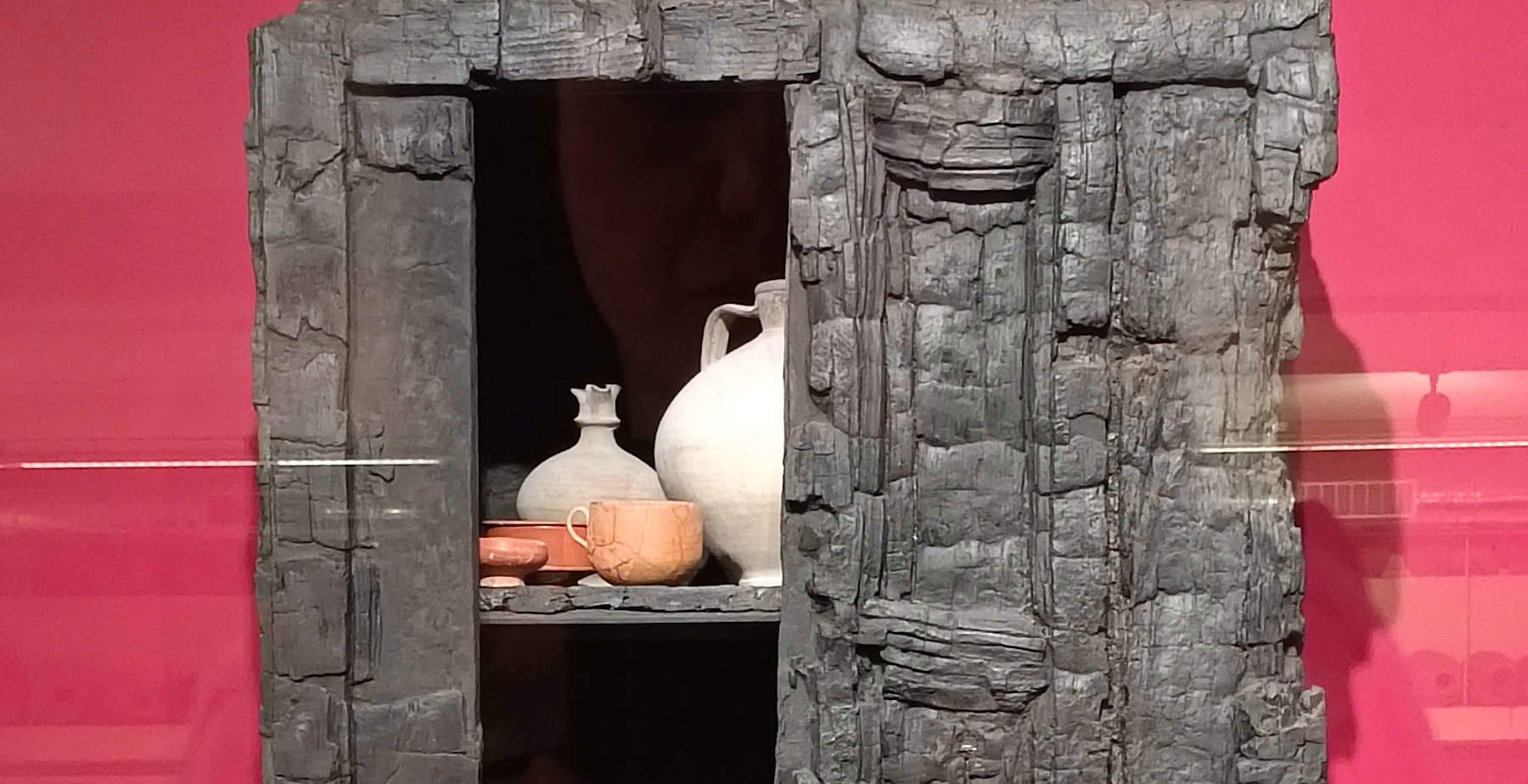After nearly ninety years, the wooden sideboard fromapartment V,18 on Herculaneum ’s Decumanus Maximus finally returns to public view. The find, one of the most extraordinary examples of domestic furniture from antiquity, has been transferred from the archaeological area to theHerculaneum Archaeological Park Antiquarium, where it finds its place in the new exhibition space dedicated to ancient woods. This concludes a long process of protection, study and restoration that has restored life and legibility to a unique object in the world archaeological panorama.
The sideboard, found in 1937 next to the Bicentennial House, is an extraordinarily well-preserved carbonized wooden cabinet, rediscovered together with its original contents: cups, glasses, jugs and pots, precious evidence of Herculaneum’s daily domestic life. The find, carefully documented in the Excavation Diaries, offered even at the time an exceptional snapshot of the private life of a first-century A.D. family, which survived in detail the drama of the eruption of Vesuvius in 79 A.D.

After the discovery, Superintendent Amedeo Maiuri, creator of the “museum city” project, wanted the furniture to remain on display in its original context. Placed on the ground floor of the workshop below the apartment and protected by a glass case, it became one of the symbols of his ambitious program to restore everyday life through in situ musealization. That set-up, however, was short-lived. For reasons of protection and preservation, the sideboard was later removed and sealed in a wooden case, where it remained for decades, far from the gaze of visitors and scholars.
Only in 2022, with the reopening of the chest, did a new phase in its history begin. The operation initiated a complex study and restoration project, carried out thanks to the collaboration between the Archaeological Park of Herculaneum and the Drents Museum in Assen, a Dutch institution that has been engaged for years in the valorization of ancient organic materials. The restoration work, completed in 2023, consolidated the structure of the cabinet and made it suitable for transport and new display, restoring its stability and legibility without altering its nature as a fragile and unrepeatable find.
The transfer of the sideboard from the archaeological area to the Antiquarium was a complex and delicate moment. Due to the fragility of the charred wood, the operation required the coordinated participation of restorers, archaeologists, technicians and specialized workers. For an entire day, teams worked with extreme caution, ensuring the safety of the artifact at every stage of the movement. The transport, accomplished with specially designed supports and cushioning systems, was a major logistical and scientific challenge.
Today the sideboard is located on the mezzanine floor of the Antiquarium, in the heart of the new exhibition space that houses ancient woods from Herculaneum. The layout has been designed to return visitors to the original atmosphere of the exhibition desired by Maiuri in the 1930s, with special attention paid to the arrangement of the artifacts and their relationship to the living context of origin. Thanks to the photographic and written documentation of the 1937 excavations, it was possible to faithfully recompose the original appearance of the cabinet, repositioning on its surfaces the tableware and household objects found inside.
The result is a vivid and authentic image of domestic life two thousand years ago, restored in its most intimate dimension. On display next to the sideboard are a cradle, a symbol of the family dimension, and the lararium found in the same room of apartment V,18, restored in 2021 thanks to the 19th edition of Restituzioni, the program for the protection and enhancement of artistic and archaeological heritage promoted by Banca Intesa Sanpaolo.
The Herculaneum Archaeological Park has also planned a program of evening visits to allow the public to admire the find in an evocative setting. As part of the initiative A Night at the Museum, every Tuesday and Thursday, from 8:30 to 11:30 p.m. (last admission at 10:30 p.m.), it will be possible to enter the Boat Pavilion, the woodwork exhibition and the gold exhibition with a reduced ticket. During these special evenings, visitors will be able to meet with archaeologists, restorers and architects from the Park, who will talk about the phases of restoration, conservation work and details of the layout, offering a direct look at the daily work of protection and research that animates the site.
 |
| Herculaneum, Roman sideboard restored after ninety years of silence |
Warning: the translation into English of the original Italian article was created using automatic tools. We undertake to review all articles, but we do not guarantee the total absence of inaccuracies in the translation due to the program. You can find the original by clicking on the ITA button. If you find any mistake,please contact us.